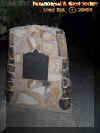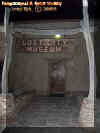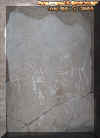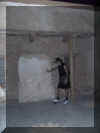|
The Lost City which once was is not consumed by the town of Overton and the Lost City Museum which was built right on top of where the village once stood. Nobody can for sure say where the lost city was however because it stretched for 30 miles. It was an advanced Anasazi civilization. The main part of the Lost City remains flooded for over 65 years under Lake Mead. Of course drought is now occurring and evidence of the Lost City are being exposed. Technically you could hike to the location but based on reading other peoples explorations a few have died trying to get to it. I know I could do it but some things are best left alone not because we fear them its because in Overton the museum gives you everything you need such as artifacts, Petroglyphs, restored pueblos and a few sites with historical markers. They called the Anasazi in this area Basket Makers or called Pueblo Grande De Nevada. They lived on the Muddy River near the Virgin River before 500 A.D. The lost city was not one city according to my studies since the name Pueblo Grande De Nevada meant lost city but the true reality it was many different cities scattered on a bluff overlooking the Valley Of Fire. The Indians built pit houses and eventually two to three story houses to live in. They would hunt around the Valley of Fire gathering their food while later they farmed on the river. Mesa House is a term they use for the last occupational period in this area. The Mesa House period lasted from 1100 to 1150 A.D. The Lost City exaction began in the 1920s under the Southwestern Museum while in the 1930s the work became extensive with the many finds of artifacts and reconstructed Pueblo Houses in Overton. Nobody knows what happened to the Anasazi they mysterious vanished much like in Arizona. In Arizona one day the entire village disappeared with food still cooking over a fire. The incidents in this case are similar not sure if when the water started to dry out they moved on...if disease swept through killing all but a few....if they were abducted by aliens nobody really knows. This was an advanced civilization that died very few native American tribes ever built homes but the Anasazi did. Eventually the Moapa Indians overtook the area in history its a fact that when one tribe dies out another tribe wanders such lands to hunt and farm. You also have to consider back hundreds of years ago this area was alot cooler then it is today. This might not be the Lost City in South America but at one time it was a prestigious city that thrived. I mean honestly the Valley Of Fire and this area we investigated tie into one another. The Anasazi needed the Valley to live just as the Valley invited the Anasazi to hunt at at least according to the Petroglyphs on the canyon and valley walls. I think the message is more important then the ghost with this exploration as without sites like mine nobody would ever know who the Anasazi area they deserve to be remembered afterall this was there land before ours. I also think that their is a lesson to be learned from all of this. Stick with the Museum otherwise you might spend your last moments dying in the desert. Its not hard to survive in the desert if you know how to survive but if your a group like mine trying to show off please take caution I have had a taste of this area I know what can happen its not worth visiting a site that's underwater but if you feel the need to want to see it then we will team up and help eachother get to the real lost city location which I have an idea where it is! © By Lord Rick-AngelOfThyNight
For
Educational Purposes Only as long as author is included below!
|
||
|
|
||
|
|
||
|
society, Mib, conspiracy, time travel, specters, Armageddon, prophets, prophecy, paranormal, ghosts, aliens, Buffalo, haunted houses, cryptozoology, dimensions, apocalypse, Atlantis, curses, monsters, wildman, yeti, cemetery, stigmata, vampyre, vampires, angels, bizarre, metaphysics, Atlanta, Louisiana, Myrtle Beach, planet x, mothman, jersey devil, apparitions, werewolf, werewolves, devils, vortexes, Bermuda triangle, lycanthropes, mystery, ancient, spirits, cydona, mythology, Charlotte, Atlanta, Mobile, possession, possess, mailing list, parapsychology, poltergeist, evp, investigation, crop circles, Roswell, abduction, project blue book, living dinosaurs, religious miracles, ny, sightings, north Carolina, south, brown mountain, cleansing, shadowmen, beast, ogopogo, death, portals, spontaneous human combustion, zombies, ouija boards, nostradamus, Edgar Cayce, art bell, George Nooray, Magick, Paganism, Wicca, Tennessee, Halloween, bigfoot, Sasquatch, ufo, grays, ufos, vortexes, alien, hybrids, Haunting's, demons, demonology, occult, mystics, lochness, chupacabras, equipment, Thermal, EMF, Cassadaga, energy, asteroid, civil war, spooky, scary, adventure, ectoplasm, orbs, graveyards, demons, spirits, cults, buffalo, new York, ghost society, logo wear, equipment, books, videos, music, certification, Castles, Forts, fortean, phenomena, nonprofit, business, investigations, SPH, EMF, ghosthunting, organization, conventions, hollow earth, paranormal & ghost Society, detector, posters, mailboxes, donate, Buffalo, xfiles, Ectoplasm, magick, spells, wicca, paganism, holy, cross, NWO, Patriot, 911, September 11th, tours, cryptid, ghostlights, dinosaurs, Florida, Fl, Daytona Beach, Jacksonville, St. Augustine, Debary, Miami, Tampa bay, Sarasota, Pensacola, NASA, Cape Canaveral, Space Coast, space shuttle, gulf breeze, key west, Sanford, port orange, Ormond beach, New Smyrna, Orlando, Disney world, Tallahassee, Stetson university, panama city, Alabama, Georgia, Savannah, New Orleans, Cocoa Beach, Ocala, plantations, Fort Lauderdale, Melbourne, Naples, Lake Wales, grim reaper, everglades, Seminoles, big cats, Fort Myers, St. Petersburg, Lakeland, Gainesville, West Palm Beach, bike week, spring break, Deland, Deltona, Orange City, weird, strange, bizarre, mysterious, rituals, skunk ape, adventure, ships, ghost pirates, ball lightning, x-files, conspiracies, Las Vegas, California, Nevada, wild west, Mojave, Navajo, timucuans, Seneca's, Iroquois, Cult, Occult, Indians, Historical, Bands, Gothic, New Age, Spiritualism, Parapsychology, CA, California, youtube, media, hard rock, heavy metal, Portal, 666, demons, fallen angels, gods, CA, Reno, Las Vegas, Sacramento, San Francisco, Roseville, Woodland, Davis, Los Angeles, Oakland, San Jose, Lodi, Napa, Vallejo, San Andreas, Modesto, Tahoe, Santa Rosa, Redding, Yuba City, San Diego, Eureka, Chico, Fresno, Salinas, Stockton, Oxnard, Auburn, Fairfield, Vacaville, NV, Carson City, Nevada, Eldorado, Yosemite, Merced, Hollywood, Eugene, Oregon, Salem, Portland, Bend, Boise, Salt Lake City, Seattle, Washington, AZ, Phoenix, Native American Folklore, Beatty, NV, Sin City, Mines, Bakersfield, Fresno, Jackson, San Andreas, Sutter Creek, Folsom Lake, Citrus Heights, Redding, Sierra Nevada's, Foothills, Spaniards, Savannah, Kinzua, Hoover Dam, Henderson, 420, Marijuana, weed, pot, joint, science, caves, spelunking, stunts, extreme, desert, woods, swamps, caving, tunnels, catacombs, UE, Urban exploration, abandonment's, video, movies, production, new age, ambient, techno, Satanism, convention, conferences, thermal detector, digital recorder, d5, deggi5, abandoned, trespass, trespassing, death, druid, curse, cursed, Chumash,Hupa ,Mission, Nez Pace, Pajute, Pomo, Salish, Ute, Creek, Cherokee, Chickasaw, Pueblo, Hopi, Anasazi, Apache |
|





































